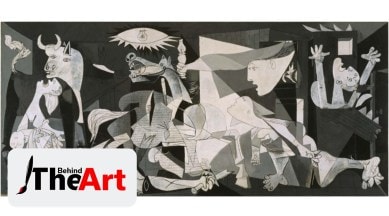📣 For more lifestyle news, click here to join our WhatsApp Channel and also follow us on Instagram
Behind the Art: Is ‘Guernica’ Pablo Picasso’s best work? What meaning does it hold?
While it is clear Picasso wanted to protest against the nature of war, why did he choose to paint Guernica and is it his best work?

I remember the first time I laid my eyes on Pablo Picasso’s Guernica. The large oil painting that the Spanish artist painted in 1937 now hangs in the Museo Reina Sofia in Madrid, Spain and sticks out like a sore thumb. Not just for its vastness but also for the imagery shown in it, it is impossible to take your eyes off it. Only when you see it in person do you realise how powerful this anti-war painting is. It is 3.49 meters (11 ft 5 in) tall and 7.76 meters (25 ft 6 in) across in size and portrays the suffering brought by violence and chaos. Prominent in the composition are a gored horse, a bull, a screaming woman, a dead baby, a dismembered soldier, and flames. While it is clear Picasso wanted to protest against the nature of war, why did he choose to paint this and is it his best work?
Story behind the art
When one thinks of Picasso, one thinks of cubism and his love for women and animals. One also thinks of the different periods he chose to paint using certain colours or objects. And then comes Guernica which has its own category – war. Picasso painted Guernica at his home in Paris in response to the 26th April 1937 bombing of Guernica, a Basque Country town in northern Spain. Nazi Germany and Fascist Italy ruthlessly bombed the town at the request of Spanish Nationalists. Picasso wanted to bring the world’s attention to the 1936-1939 Spanish Civil War and what better way to do it than through artwork? This painting was exhibited at the Spanish display at the 1937 Paris International Exposition, and at other venues around the world which helped raise funds for Spanish War relief.
When you look at the painting, it seems as if Picasso was so passionate about what he was painting when in reality it took him time to get to that point of intensity. He worked somewhat dispassionately from January until late April on the initial sketches. And then everything changed when he heard about the 26 April bombing of Guernica. His friend and poet Juan Larrea visited Picasso and urged him to make the bombing his subject. American artist John Ferren then assisted him in preparing the canvas and his mistress Dora Maar documented its creation as an experienced photographer. It is this documentation that would act as a publicity tool for the painting as Picasso rarely allowed strangers into his studio to watch him work. Guernica was an exception and it is said that he admitted influential visitors to observe his progress on the painting. While talking about his painting, he said “I clearly express my abhorrence of the military caste which has sunk Spain in an ocean of pain and death.”
Symbolism and its significance
It took Picasso 35 days to finish this masterpiece. He chose to paint this using matte house paint to avoid the glossy effect paintings have. I had never seen a black and white painting before that was so impactful. The symbolism and the images shown shocked me as well. You see a wide-eyed bull on the left with a tail suggesting rising flame and smoke as seen through a window standing over a grieving woman holding a dead child in her arms. Once you overcome what you have seen on the left side, you are faced with a falling horse who is in agony in the centre of the painting with a large gaping hole in its side. A dead and dismembered body of a soldier is seen lying under the horse. These are just some of the symbolism of war that you get to see in the painting. It is full of devastation, pain and agony and the painting moves you. You cannot help but be both horrified and fascinated by the images Picasso has so carefully painted on the canvas. However, the interpretation just like in an artwork defers on the viewer. For example, the interpretation of the two main images in the painting – bull and horse has varied for critics and historians alike. According to Art historian Patricia Failing, the bull and the horse are important characters in Spanish culture and Picasso used these characters to play many different roles over time. Ironically, when the Cubism master himself was asked about the meaning of the bull and the horse, he said “…this bull is a bull and this horse is a horse… If you give meaning to certain things in my paintings it may be very true, but it is not my idea to give this meaning.”
The relevance and importance of the painting can be seen in the symbolism. I consider Guernica to be an icon of modern art, the Mona Lisa of our time, and Picasso’s best work to date. And as Leonardo da Vinci spurred a Renaissance ideal of serenity and self-control, Guernica should be seen as Picasso’s comment on what war can do and how art can protect us against overwhelming forces such as political crime, war, and death. These topics are still relevant to us and will continue to be till the concept of war exists.
Next up in Behind the Art: Why is The Milkmaid by Johannes Vermeer famous?
📣 For more lifestyle news, follow us on Instagram | Twitter | Facebook and don’t miss out on the latest updates!
📣 For more lifestyle news, click here to join our WhatsApp Channel and also follow us on Instagram